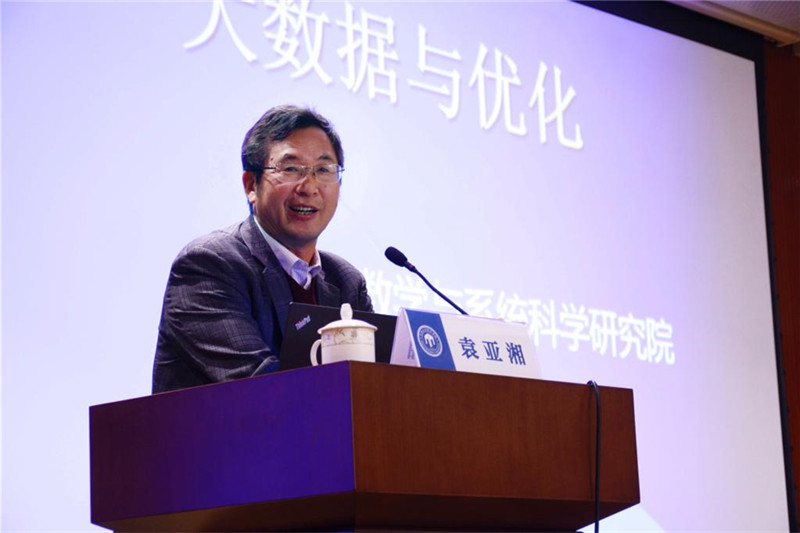The information storm of big data has brought us is changing our life, work and the way of thinking, and optimization is one of the powerful tools to decrypt data. On the morning of November 1, 2018, a lecture about Big data and Optimization in the lecture hall of administrative building in Peiyang Park Campus of Tianjin University. The lecture is given by Yuan Yaxiang, academician of Chinese Academy of Sciences, academician of Third World Academy of Sciences, director-general of Chinese Mathematical Society and chairman of China Association for Science and Technology, and presided over by Sun Xiaotao, dean of School of Mathematics.

Professor Yuan first analyzed the emergence of practical problems and mathematical fields involved in big data. Data science is a hot topic nowadays, and data science centers are constantly emerging. Data is growing exponentially, involving medicine, education, transportation and other fields, and every aspect of our lives generates a lot of data all the time. However, most of them have not been effectively utilized. What data science do is to study the regularity, classification and prediction of these data.
Yuan believed that the problem of data is an approximation problem. For mathematicians, it is a problem of data fitting to establish a correspondence and find a function. And the so-called optimization is to find a function to make error between function and the real correspondence as small as possible.

Professor Yuan introduced optimization problems and main optimization algorithms which have attracted much attention in the world, such as regularization, compressed sensing, matrix completion, distance geometry, classification, gradient method, random gradient method, alternating direction method, etc. in plain and easy-to-understand words, explaining essence and key of these profound methods in simple language and uncovering mystery of data science and optimization research for teachers and students present.

In explaining compressed sensing, Yuan made an on-site interpretation. When solving a linear system of equations, there is a situation where there are a lot of variables, up to tens of billions, and there are also a lot of equations, up to hundreds of millions. There are a lot of solutions to this system, and compressed sensing is to find as many solutions as possible with zero vectors, that is, the most sparse solution.

It is one of the important works of the famous mathematician Terence Chi-Shen Tao which he proved that a norm minimum is equivalent to zero norm minimum under certain conditions, which is equivalent to proving that a non-convex problem is equivalent to a convex problem in a certain sense. By transforming a difficult problem into an easy one, we can use polynomial algorithm to solve it.

The optimization study of data science contains some inspirations from learning and life. Professor Yuan concluded at last that some classical mathematical methods were still useful in solving new problems in the new era; Complex problems often had special structures, which needed to be simplified and divided to solve; Basic mathematical theory was powerful, and the development of data science and other disciplines could not be separated from basic mathematics.
Students in undergraduate grade two asked a question about the application of polynomial function fitting in data science. Professor Yuan answered that actual data problems were often complex and that in higher dimensional space, the essence of the commonly used fitting function was linear function plus piecewise function, which was constructed by the combination of multi-layer simple functions and it was complex and impracticable to use merely polynomial function approximation in high-dimensional computation.
Audiences with economic background asked whether function fitting could be used to accurately fit the effects of kinds of agricultural factors such as weather, fertilizers, seeds and even production and management modes on output. Professor Yuan affirmed that from the perspective of mathematicians, there must be correspondence, that is, functional relationship among any objective things and because of complexity of the objective world and limitation of human cognitive constraints, we couldn’t accurately write this function, so we studied data, to interpolate, to fitting and to constantly approach the reality.
It turned out that we could understand the profound mathematical theory in such a relaxing atmosphere. The mathematics class can not only impart knowledge and cultivate ability for us, but also affect our values. Warm applause resounded again and the lecture ended successfully, but the enlightenment brought to teachers and students still echoed in everyone's minds for a long time.
By: Zhang Jiawei, Ma Changying
Editor: Qin Mian and Keith Harrington






